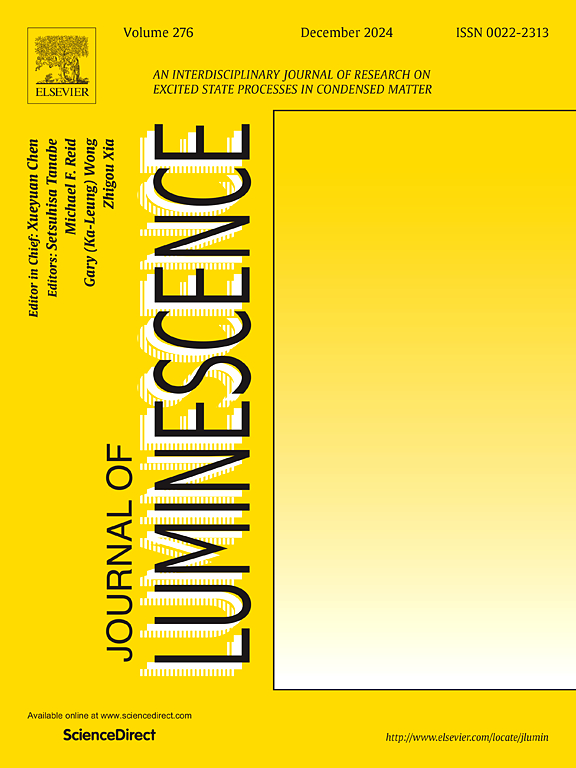In vivo real-time and in situ sensing of nitric oxide in virus-infected mouse lungs using organic near-infrared-to-visible triplet–triplet annihilation upconversion nanoprobes
IF 3.3
3区 物理与天体物理
Q2 OPTICS
引用次数: 0
Abstract
Nitric oxide (NO) is a crucial gaseous signaling molecule, and its local concentration fluctuations in vivo can reflect the onset and progression of various pulmonary diseases, such as idiopathic pulmonary fibrosis and viral lung infections. Previous studies have demonstrated a positive correlation between in vivo NO concentration and disease progression, highlighting the urgent need to develop a class of bioprobes capable of highly sensitive and specific real-time NO sensing within living organisms. Herein, we report a “turn-on” near-infrared fluorescence sensing nanoprobe for nitric oxide (NO), which integrates a near-infrared-to-visible triplet–triplet annihilation upconversion (TTA-UC) system with an NO-responsive Bodipy dye. By co-encapsulating both components into the amphiphilic polymer F127, we constructed TTA micelles with excellent photostability and biocompatibility. In vitro studies demonstrated that the TTA nanomicelles can sensitively and specifically respond to exogenous NO. In a pseudotyped mouse model of pulmonary viral infection induced by SARS-CoV-2 spike protein (SP), the upconversion fluorescence of the TTA nmicelles was gradually activated over time, indicating that the developed nanoprobe can dynamically reflect the real-time progression of lung infection in mice. Therefore, the TTA micelles can rapidly diagnose the onset of lung infection at early stages, thereby potentially improving the efficiency of subsequent treatments.
利用有机近红外到可见三重态湮灭上转换纳米探针对病毒感染小鼠肺部一氧化氮的体内实时和原位传感
一氧化氮(NO)是一种重要的气体信号分子,其在体内的局部浓度波动可以反映各种肺部疾病的发生和进展,如特发性肺纤维化和病毒性肺部感染。先前的研究表明,体内NO浓度与疾病进展之间存在正相关关系,因此迫切需要开发一类能够在活体内高度敏感和特异性实时检测NO的生物探针。在此,我们报道了一种“开启”的一氧化氮(NO)近红外荧光传感纳米探针,它将近红外到可见的三重态-三重态湮灭上转换(TTA-UC)系统与NO响应的Bodipy染料集成在一起。通过将这两种组分共封装到两亲性聚合物F127中,我们构建了具有优异光稳定性和生物相容性的TTA胶束。体外研究表明,TTA纳米胶束对外源NO具有敏感性和特异性反应。在SARS-CoV-2刺突蛋白(SP)诱导的肺部病毒感染伪型小鼠模型中,TTA胶束的上转换荧光随着时间的推移逐渐激活,表明所开发的纳米探针可以动态反映小鼠肺部感染的实时进展。因此,TTA胶束可以在早期快速诊断肺部感染的发病,从而有可能提高后续治疗的效率。
本文章由计算机程序翻译,如有差异,请以英文原文为准。
求助全文
约1分钟内获得全文
求助全文
来源期刊

Journal of Luminescence
物理-光学
CiteScore
6.70
自引率
13.90%
发文量
850
审稿时长
3.8 months
期刊介绍:
The purpose of the Journal of Luminescence is to provide a means of communication between scientists in different disciplines who share a common interest in the electronic excited states of molecular, ionic and covalent systems, whether crystalline, amorphous, or liquid.
We invite original papers and reviews on such subjects as: exciton and polariton dynamics, dynamics of localized excited states, energy and charge transport in ordered and disordered systems, radiative and non-radiative recombination, relaxation processes, vibronic interactions in electronic excited states, photochemistry in condensed systems, excited state resonance, double resonance, spin dynamics, selective excitation spectroscopy, hole burning, coherent processes in excited states, (e.g. coherent optical transients, photon echoes, transient gratings), multiphoton processes, optical bistability, photochromism, and new techniques for the study of excited states. This list is not intended to be exhaustive. Papers in the traditional areas of optical spectroscopy (absorption, MCD, luminescence, Raman scattering) are welcome. Papers on applications (phosphors, scintillators, electro- and cathodo-luminescence, radiography, bioimaging, solar energy, energy conversion, etc.) are also welcome if they present results of scientific, rather than only technological interest. However, papers containing purely theoretical results, not related to phenomena in the excited states, as well as papers using luminescence spectroscopy to perform routine analytical chemistry or biochemistry procedures, are outside the scope of the journal. Some exceptions will be possible at the discretion of the editors.
 求助内容:
求助内容: 应助结果提醒方式:
应助结果提醒方式:


